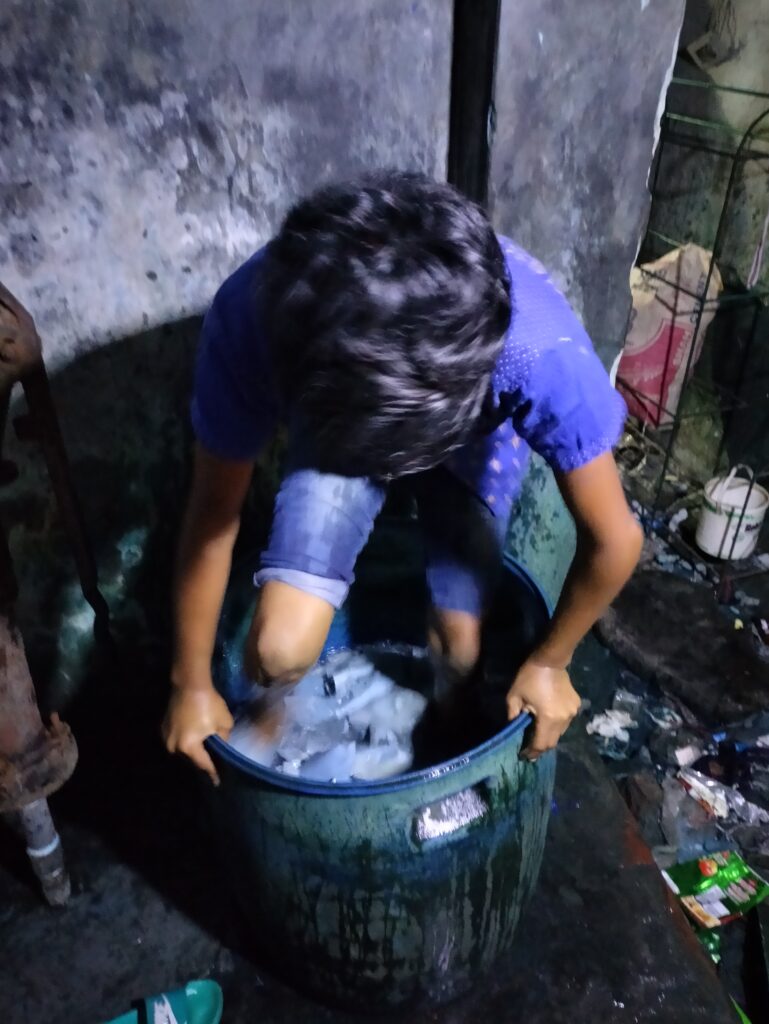“In this sector both the employers and the staff members are poor”
The realities of running a small leather-cutting business in Hazaribagh
Introducing Jawad and Lana Leather Goods
Jawad is in his mid-thirties. He established a small glove manufacturing factory at Gojmohal, Hazaribagh in the city of Dhaka in 2016 with a loan of BDT 250,000 (USD $2,250) from his brothers. He was forced to close this business in 2020 due to losses because of the Covid-19 pandemic. To repay all his loans he sold all his sewing machines.
When he started thinking about setting up a new business, he was told about a slightly malfunctioned cutting machine for sale at another factory. He paid BDT 12,000 (US $140) for the machine instead of the market value of BDT 80,000 (US $940) and he gave BDT 5,000 (US $59) to the person who informed him about the machine.
The purpose of Lana Leather Goods, Jawad’s current business, is to supply cut leather to local leather manufacturing businesses who make gloves, key rings, wallets, and boots. Jawad buys his leather from traders and shops in local markets in Bangshal. These traders and shops get their leather from small business owners, who go and collect lower quality leather offcuts from businesses that focus on making higher quality leather to supply export-oriented manufacturing factories.
Today, in 2022, Jawad’s new business is going well. He is well connected in the locality to different clients and is specialised in cutting. He reflects:
“My new factory’s age is not yet two years, but I get the highest number of orders in this locality”.
The factory is a 8 x 4 metre brick building with a tin roof.

A corridor outside the factory
Two children aged 12 and 16 work at Lana Leather Goods as respectively a “helper” and a “cutter”.
Workers are paid according to what they produce. They do not work fixed hours, although their days are long.
Jihan, 12 years old
Jihan lives with his grandparents in Hazaribagh. He was previously at school in his home village. During the COVID-19 pandemic his school closed. Jihan’s father did not have work and took out loans of BDT 400,000 (US $3,600) from a brick field owner. He then worked in the brick field to repay the loans but the money was not enough to secure a livelihood for his family. So, he moved to Dhaka to work in transportation and brought Jihan with him. Jihan has been working at the factory for one month, as a helper to the ‘cutter’.
Jihan gets paid BDT 4,500 (US $40) as a monthly salary plus BDT 40 (US $0.40) each day for snacks. He gives what he earns to his father.
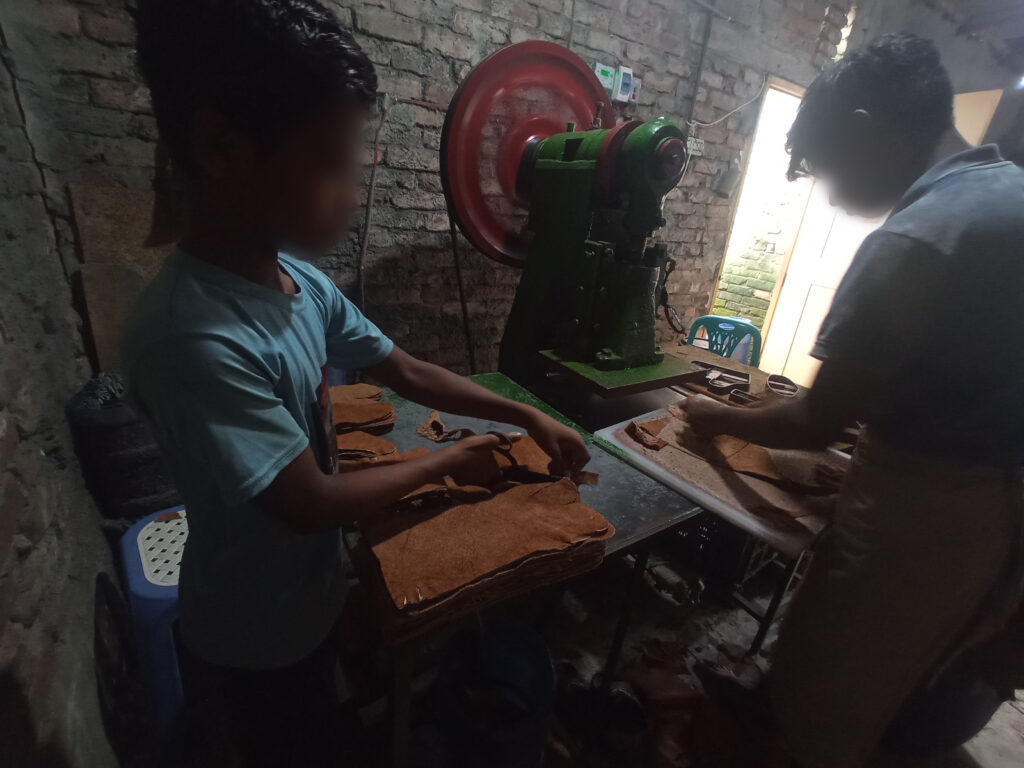
Children working inside the business unit.
Aniket, 16 years old
Aniket lives with his parents. Three or four years ago, he started working as an apprentice. He left school after his parents pressured him to start work in order to make a financial contribution to his family. He is the cutter or “cutting man”.
Aniket is paid on a production basis and can earn from BDT 500-700 (US $4-6) per day. To earn BDT 500 (US $4) day, he cuts at least 300 pieces of leather for gloves. He does not like to work every day.

Piles of leather in the factory
Work shadowing with Jawad
In June 2022 CLARISSA researchers accompanied Jawad for four consecutive days to observe in detail the day-to-day realities, practices and pressures of running an informal leather cutting business.
While Jawad opens his factory most days at 6am the workers begin arriving at 8am, so it was agreed the CLARISSA researchers would be in the workplace from 8am each day, observing the workers and the processes they conducted, initiating informal discussions and gathering primary evidence of the multi-dimensional activities of the business. Photos were taken with consent from both factory owner and the individual staff members. The researcher documented conversations and at the end of each day recorded their observations.
During the work shadowing exercise researchers spent time with two child workers, and one young boy who was working for another business in the supply chain, collecting waste leather. There was also an opportunity to meet and observe discussions between Jawad and two clients who visited the factory. All names are pseudo names to protect identities.
What happened at the leather cutting factory
Day 1
On the first day of shadowing Jawad arrived at the factory at 6am. He worked on the cutting machine from 6am-9am before the other workers needed it.
At 8.30, the youngest worker arrived. Jihan (12) began cleaning up leather waste. When he finished his cleaning tasks, around 10 am, Jawad told him to bring tea and snacks for everyone from a local restaurant. Jihan came back quickly, as the restaurant was near the factory. By that time, the cutting operator Aniket (16 years old) had arrived at the factory and had taken charge of the cutting machine. Jihan started helping him, by fetching and bringing raw materials.
A client arrived at the business to speak to Jawad. Their exchange was revealing about the approach Jawad takes to prioritising work:
Client: Hey! What’s up? Have you started doing my work?
Jawad: No. Not yet. First, I’ll have to finish the work of (another client). After that, I’ll start your work.
Client: But I gave you my leather before (another client). Then why will you start my work after him?
Jawad: During the lockdown, when I did not have any work, then (the other client) helped me by giving me money. So, what do you think? Is there any comparison between you and him?
Client: No. Of course not. I understand.
It is accepted that the other client’s order should be prioritised because of the credit or loan agreement Jawad has with him.
The CLARISSA researcher notes how unbearably hot the day has become, but the client replies “Do not utter a single word against the sun. It is needed”. Jawad explains that his client is dyeing his leather, so the sun is very important to him for the drying stage.
Everyone went to their homes for lunch. In the afternoon, Aniket and Jihan were cutting leather for keyrings. Jihan was mainly responsible for observing a piece of leather for defects. Aniket was responsible for setting the dice (knives) on the better parts of the leather and pressing the machine to make a cut. After cutting the parts, Jihan separated the cut pieces from the big pieces of leather. He counted and arranged them. Jawad monitored their work to ensure Aniket and Jihan were using the leather efficiently. Clients become dissatisfied if they do not cut sufficient numbers of pieces from the leather.
At 4.30 pm Jihan went to a local restaurant to get tea and biscuits for everyone. After that, everyone worked while eating.
At 7.15 pm Jawad calculated the total pieces produced that day, logging the number in his register book according to the date, the number of leather pieces used, and the number of pieces cut. After this, he packed up 1,320 pieces of key ring parts with Jihan.
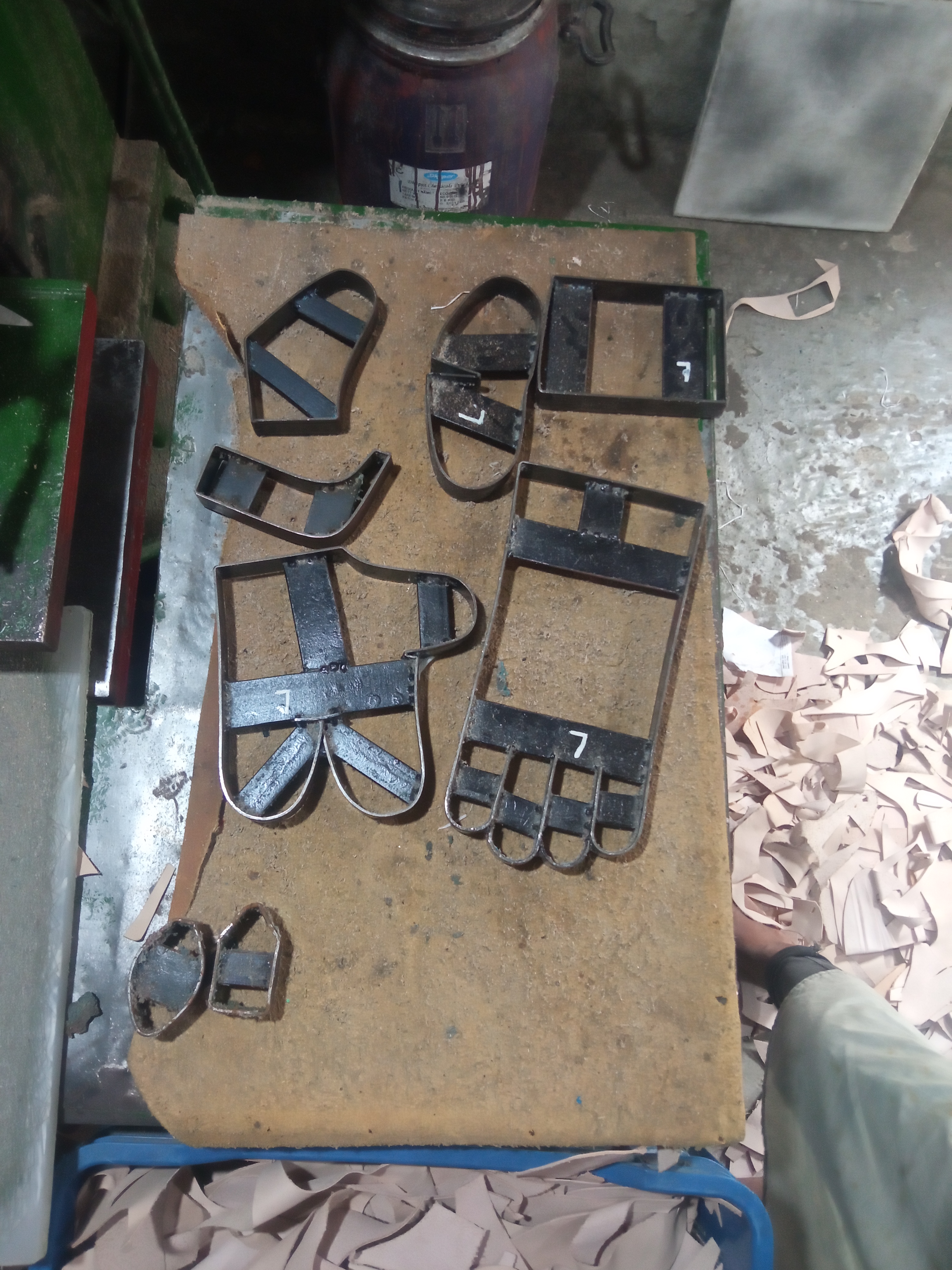
Jihan and Aniket left at 8.30pm for home. Jawad did not leave. He started cutting, working until midnight.
Day 2
The factory was open when the researcher arrived at 8am. Aniket and Jihan were working but Jawad was not there.
When Jawad returned, he scolded Jihan for not cleaning the factory premises. At first, he slightly yelled at him. Afterwards he explained:
“If you do not clean the factory, it will become dirty, and your health will be affected.”
Jihan started sweeping the floor and then started helping Aniket in cutting. All of them worked just like the previous day until 10:00 am, when Jawad sent Jihan to the local restaurant to buy tea and samosas.
Again, they worked while eating. They did not break and relax.
At 11.30 am a young boy came to the factory to collect waste leather and had the following exchange with Jawad:
Jawad: Who has sent you?
Boy: Akkas Uncle.
Jawad: Oh! Akkas Bhai? Okay, take the waste. But you’ll tell your uncle to pay you some pocket money for having some snacks.
When the child left the factory, Jawad explained:
“Previously, the waste leather was very valuable. Waste leather was used as fish feed or as fuel. But now, the government has banned that business because processed leather contains a huge amount of chrome which is harmful to health. Now, the waste leather is only used for polishing iron nails and things like that”.
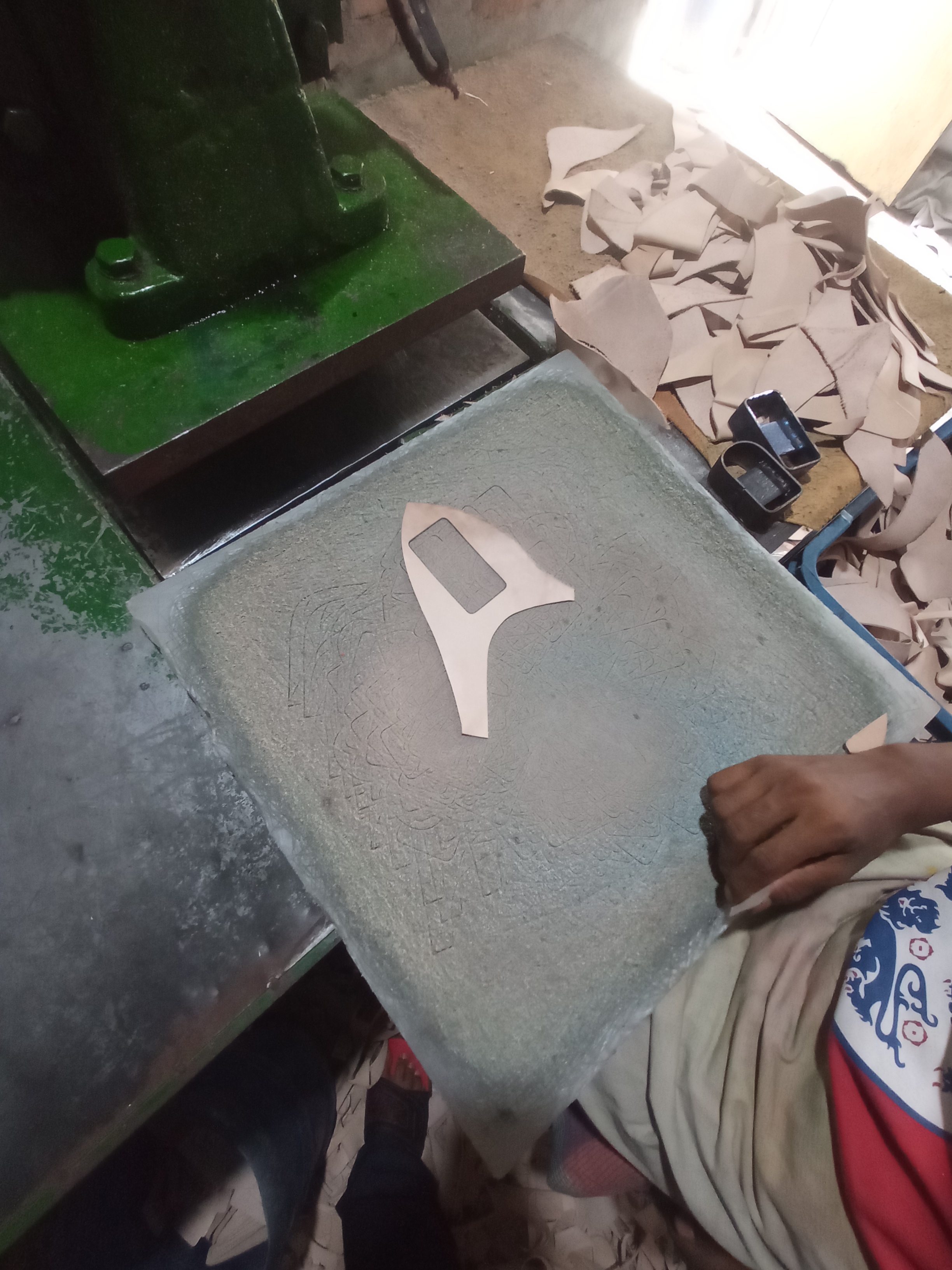
Everyone had lunch at home at 1.30pm and the afternoon work took place between 2.30-8.45pm. They cut 1,286 pieces of leather under Jawad’s monitoring. When the children went home Jawad began cutting again.
Day 3
When the researcher arrived at mid-morning the factory looked different. On previous days the unit had been covered in orange colour leather. Now the place was full of coffee coloured leather.

Jawad said he had received a new contract, this time to cut 2,000 pieces for glove production. He was delighted, saying that the client will pay a higher rate because he has to deliver in a short period of time.
Aniket used two types of dice to cut the leather. One was the shape of four fingers, and another was the shape of a thumb. Jihan separated the cut leather from the big pieces and counted them.
Everyone had snacks and lunch at the usual time.
At four in the afternoon Jawad received a phone call from one of his clients. After the conversation, he told Jihan to arrange a packet of 1,000 cut pieces for key rings and deliver them to the client’s factory.
Jawad explained how this client is the biggest in the locality, who sometimes outsources to deliver products to buyers on time. He takes cut leather and makes finished key rings, suppling businesses all over the country. The researcher asked if he could accompany Jihan on the delivery. Jawad’s response was insightful:
“I don’t have any problem. But they will not permit you to enter their factory. That is an export-oriented factory but employs children for working. That’s why they do not permit any unauthorised person to enter their factory. But if you really want, you can go and see it”.
Around 4:30 p.m. Jihan and the researcher started their journey on foot to hand deliver the cut leather to a factory in the Hazaribagh. True to Jawad’s prediction, only Jihan could enter the factory. The researcher waited outside and after he and Jihan went to a local restaurant to buy tea and biscuits.
Everyone worked until 8.30pm, until 148 pieces of leather had been cut into shapes for the gloves. Jawad was not feeling good, so he also left for home.
Day 4
On the fourth day of shadowing, the researcher arrived at 8.30. Aniket and Jihan were working. Jawad was suffering from a fever.
After some time, Aniket started teaching Jihan how to operate the cutting machine. This had not been observed on previous days. It seemed as though they took the opportunity while Jawad was not there. Aniket explained:
“I am his ustad (mentor). I teach him to operate the cutting machine. I let him do the task by himself. If someone does not learn anything practically, his learning will be incomplete. I want him to learn the skill quickly so that he can earn a better salary. If I can teach him properly, he will remember me as a good ustad his entire life”.
The boys worked until 1.00 pm. In the afternoon a client came and asked for Jawad. Aniket explained he wasn’t there so the client began inspecting pieces of the cut leather. He used abusive language with Aniket and Jihan telling them to improve the quality of their work. When the client left Aniket explained the behaviour as a consequence of the agreement:
“We’ll have to deliver cut leather for 4,000 pieces of key rings. Our employer has taken advance payment from him. When the clients pay some advance payment, they impose different conditions. They demand the best quality. But when they take deliverables on credit, they do not say anything about the quality.”
In the afternoon, Aniket and Jihan spent some time, in between working, playing games and watching YouTube on Aniket’s phone. They also took some rest. They were enjoying their freedom.
At 6.30pm the boys shut the factory and went home.
An unhealthy working environment
The premises of Lana Leather Goods only has one door and one window. It is dark inside, and very hot. The electric light and the two ceiling fans are not sufficient. The sound of the cutting machine is continuous and intense in such a small space.
The floor is covered in waste leather. This is an issue because waste leather is known to be poor for human health. Jawad insists on cleaning it up. It can no longer be sold for fish food, as it has been in the past. Sodium dichromate is the principal raw material used in the chrome tanning process and it is a carcinogen causing damage to blood, kidneys, soft tissues and lungs, as this review article on occupational cancers in leather tanning industries explains. But, despite efforts at cleaning up, the child workers are surrounded by leather 12-13 hours a day, six days a week. When work pressure is high, they work seven days a week. No chemicals are used in Jawad’s factory, but dyeing takes place as part of the tanning process in the unit next door and an acute foul smell of chemicals permeates the workplace.
There is a water filter on the premises so that the workers can drink safe water. There is a toilet, but it is in poor condition and is also used by 20 other tenants and workers in the building. Jawad doesn’t use the toilet – he goes home to use the toilet there instead.
The workplace is unsafe for children in another way. As the fourth day of the work shadowing illustrated, sometimes they are working unattended by an adult. And this put them in direct contact with clients who are verbally abusive and criticise their work. The children can also be scolded by Jawad.
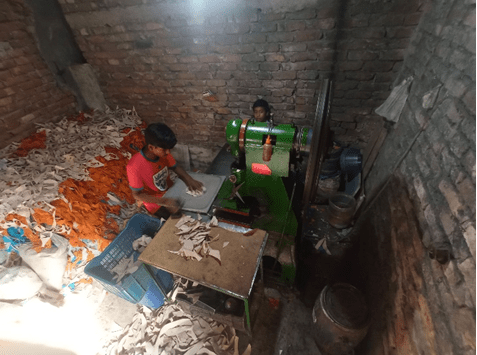
Children working with waste leather in piles on the floor behind them
The use of children as cheap labour
It was the view of the children that they were hired so that Jawad could pay them less. Jawad does not want Jihan to learn to cut, because once he has new skills, he can switch factories and earn more money. This is why Aniket teaches him when Jawad is not around.
A look at the economics of the business also suggests that cheap labour is a requirement for a viable operation. Jawad is paid BDT 1.60 (US $0.01) per key ring for the cutting his business undertakes. Other businesses in the production process add foam, loops, and rings and sew the pieces. The finished pieces will sell for a retail price of BDT 60 – 200 (US $0.50-1.81). He reflected:
“You may ask me why I work at such a low price. We do only cutting. It does not require so much time. And there is no point to sit idle”.
After bearing the cost of raw materials, Jawad can make a profit of BDT 0.60 (US 0.005) per key ring.
Cutting leather for gloves requires more capital but can make a higher profit per piece that is cut (BDT 8, or $0.073). Over the month, Jawad can earn BDT 20,000-30,000 (US $191-287) a month, depending on the number of orders. Aniket earns according to what he produces, usually between BDT 500-700 (US$4-6) a day if he can cut 300 pieces of hand gloves or equivalent. Typically, Jawad pays Aniket between BDT 10,000-12,000 (US $90-100) a month, which is just below the minimum wage for workers in garment factories in 2023. Jihan, the 12-year-old helper, is paid BDT 4,500 (US $40) a month.
The small amounts that Jawad’s business is paid for its part in a larger, fragmented production process illustrates how many people along the way need to turn a profit. If all workers in the supply chain system were to receive the Bangladesh minimum wage or a living wage for the hours they work, on their part of the process, the retail price for the leather products would not support the full costs of production.
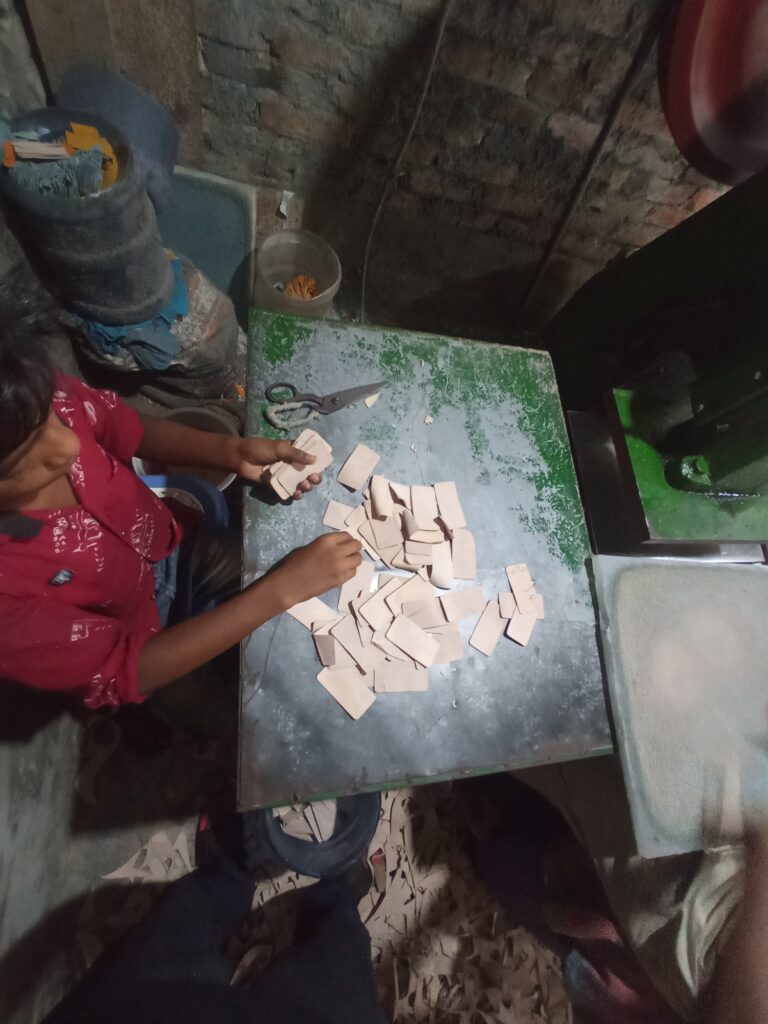
12 year old boy counting pieces of leather cut for key rings
The challenge of attracting and retaining staff
Jawad explains that he pays children 20% more than other factories do. He feels that if he does not pay higher wages the children will leave the leather sector and the leather sector as a whole will suffer:
“I think, why should I pay less? If it is needed I’ll ask for a raised rate from my clients. After working here all day long, if they cannot earn at least BDT 500 (USD 4) a day they will not get any benefit. They will shift from the sector and start working in other sectors. Then we’ll be losers. In this sector both the employers and the staff members are poor. So, we’ll have to help each other in this way.”
Regarding the 16 year old worker Jawad says:
“At his age, I used to spend time playing, roaming around with friends, and studying. Because of poverty, he is spending his time here working. This is the cruel reality of his life.”
Despite the researcher observing occasions where Jawad scolded the 12-year-old, most of the time their relationship was respectful. Jawad reflected:
“I always try to behave well with my staff members. Nowadays, it has become difficult to get workers. If I misbehave with them, they will not work with me anymore and I’ll face losses.”
According to Jawad, child labour is prevalent in the export sector as well as the domestic sector. Export-oriented companies are always on the lookout for cutters. As a result, smaller factory owners are facing huge competition when it comes to attracting and retaining staff, even when they themselves are serving clients selling into export-oriented markets.
Although staff might earn less in regulated export-oriented factories, they still want to work in them because they know that they will only have to work for fixed hours. In small units like Jawad’s workers earn more but they are required to work longer hours to meet contract deadlines. Jawad feels that the children are more motivated by shorter working hours than by working long hours for more money.
Business-to-business relationships and the credit system
Jawad works hard to maintain good relationships with clients. In one conversation over tea and snacks he gave the below example to illustrate the importance of honesty in generating goodwill and repeat business:
“For me, honesty is very important. Once, I delivered 10,000 pieces of leather for key rings. The client had given me the raw materials. We found that, with the leather they had provided, we could make 100 extra pieces of key rings (above the order amount). I delivered the commission and did not charge extra money for the additional 100. When they counted and found the 100 extra pieces, they paid me for them. If I had wanted to, I could have sold those extra pieces at a higher price somewhere else, and they even would not have ever known. But I did not do that. As a result, they trusted me and became a regular client”.
Although some of his clients’ export products to foreign countries and are themselves formal companies, Jawad does not use written contracts for commissions. Small factories like his are contracted in an off-the-record way. Instead, he says that the sector depends on trust:
“They know me; I know them. They have faith that I’ll be able to do the work according to their demand. And I know that they will pay me after I deliver them the deliverables. That’s how we are running our business. Yes, it’s true that sometimes, we face loss. But in those cases, the clients also face losses. They cannot pay us because their payments are also stuck. In those cases, written contracts also cannot save us. If they do not have money, how they will pay us? “
He does not think a written contract would help him navigate business losses when clients do not pay.
Credit and loan arrangements are more important than contracts for setting expectations about commissions. In one case, Jawad explained to a client that he was obligated to prioritise the work of another client because of previous financial help, even when the order came in later. In another case, Aniket explains that higher quality work is expected when a commission comes with some up-front payment.
The impacts of the COVID-19 pandemic
In 2020, Jawad had been running a gloves manufacturing business for four years and it was going well. When Covid hit “everything was just ruined”. He tried to run his factory for five to six months but could not get any new contracts. He continued to pay his workers and to pay his rent but was eventually forced to close the business due to huge losses. He lost all his savings and took loans totalling 200,000 (US $2,353). To repay the loans, he sold all his sewing machines and wrapped up the business.
When the situation normalised, Jawad started up the current cutting business. Rather than manufacturing the whole glove, he is now only cutting leather for gloves and the manufacture of other leather goods. He now focuses on a micro-step in the process of preparing leather, one which required much less start-up capital, especially since he bought a cutting machine with defects at a lower cost.
To sustain his business, Jawad works under a lot of pressure. He works very long days, as he is also a cutter in the business. As there is only one cutting machine, he works either side of the children’s shift working from 6am to midnight to increase the rate of production.
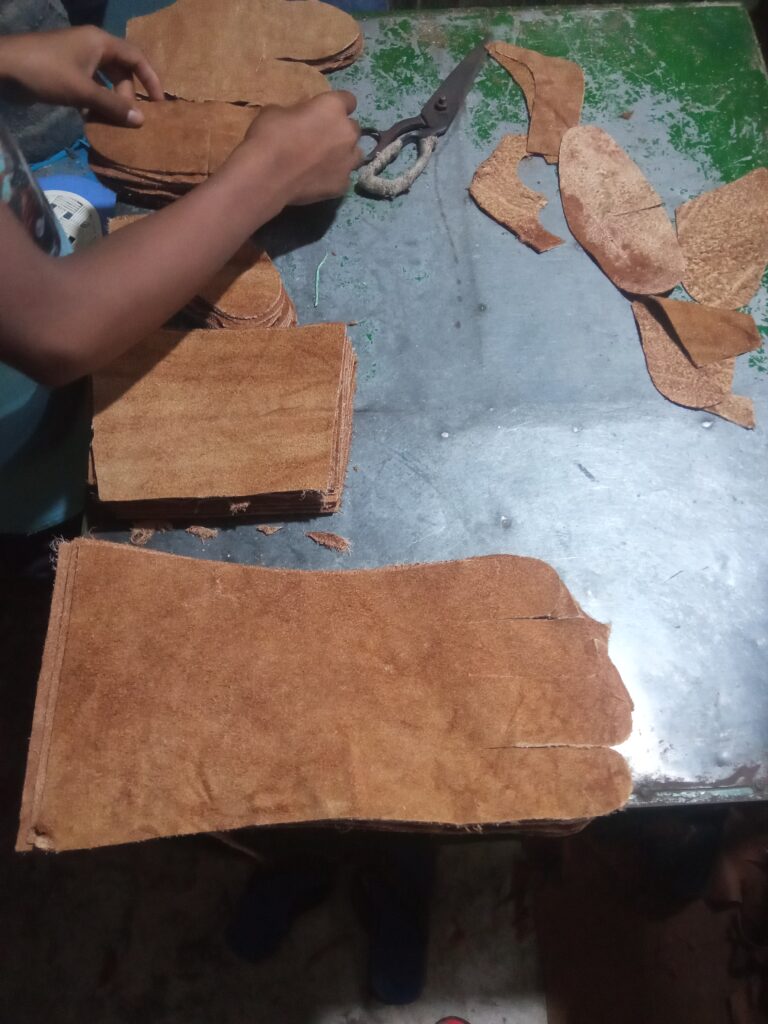
12-year-old boy is arranging cut leather for hand gloves
Conclusion
Lana Leather Goods is a small scale, informally run business that supplies domestic and export-oriented markets. The business manages a small step in a fragmented production process, smaller in scale than the owners previous glove-manufacturing business, that he was forced to close during the COVID-19 pandemic.
The business turns a modest profit for Jawad, but he works exceptionally long hours, and he hires children as cheap labour to achieve his profit margin. A window into the economics of his business suggests that the retail price points for the leather products cannot support minimum wages for workers across every step of the manufacturing process.
Lana Leather Goods employs two children. A 12-year-old worker is employed directly as a result of his family’s financial crisis during and after the COVID-19 pandemic. Both children do repetitive work over long hours in hot and unhealthy conditions, without proper breaks. Jawad reveals his awareness of the health implications of the work, explaining to the youngest the importance of cleaning up the leather so it doesn’t affect his health.
Jawad expressed empathy for the children who work for him and their financial situation and reports that he strives to retain his staff by paying higher wages than his competitors. He also worries that his staff will be lured to an export orientated factory by the prospect of shorter working hours. The children feel that their boss prevents younger workers from becoming skilled so that they are not tempted to get jobs for more money elsewhere. Both children took advantage of Jawad’s day off (when he was sick) to slow down, play and leave work after a 10-hour, rather than their usual 12/13-hour day.



